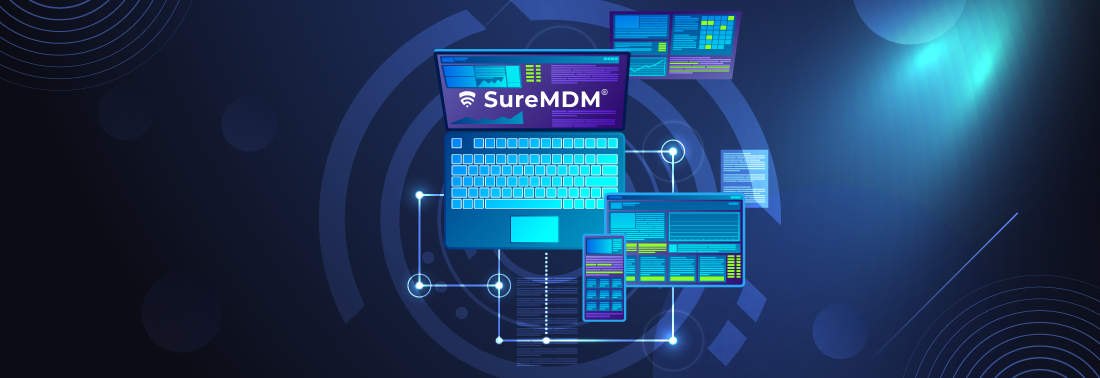What is Unified Endpoint Management (UEM)?
Feb 27, 2023 | 42Gears Team
Mobile devices and enterprise endpoints play an important role in driving today’s businesses. With the BYOD and Enterprise Mobility market expected to grow to over USD 133.9 billion by 2029 (at a CAGR of 13%), the relevance of Unified Endpoint Management (UEM) solutions for modern business requirements is at an all-time high.
With employees logging in from multiple locations and using a wide variety of devices, IT departments need a robust tool to monitor, manage, and secure their complex IT environment and employee devices. This is where an UEM takes center stage in helping IT admins manage a wide range of employee devices from a single console.
What Exactly is Unified Endpoint Management?
A UEM platform enables consolidated monitoring and management of different endpoints from a single console to ensure that organizations are able to run their daily operations smoothly and securely. With a single-pane-of-glass view, IT admins can see the status of all the endpoints.
At its core, UEM includes the use of several device management tools, such as mobile device management, mobile application management, and enterprise mobility management tools. These tools are specifically designed to help businesses monitor and manage employee mobile devices.
Organizations that have deployed a UEM solution aim to address the following issues:
- Put an end to siloed tools: Businesses often implement siloed tools and end up mismanaging mobile devices, laptops, desktops, and cloud-based devices. This can lead to security issues across platforms.
- Avoid on-site visits to manage devices: In several organizations, IT teams have to travel to different locations to manually manage users, operating system maintenance, device maintenance, and decommissioning. This results in administrative inefficiency and increases the costs associated with endpoint maintenance.
- Lack of visibility across endpoints and users: The lack of visibility across endpoints, applications, and users results in poor security and improper management of IT devices. Without a robust tool, organizations struggle to generate exhaustive reports on asset usage and patch management processes.
- Unauthorized Access Control: With the help of an UEM solution, organizations can manage data and device access based on valid accounts and security standards like multi-level encryption and unique password requirements.
Important Features of a UEM Solution
With a UEM solution, businesses can accelerate the process of performing daily IT administrative tasks by automatically managing and monitoring a fleet of devices.
Let’s look at some of the key functionalities of a UEM solution:
Device Management
The primary capability of a UEM solution is device management. It helps businesses keep endpoints secure. A UEM solution can be used to configure all devices in an organization to adhere to specific device management policies set by the IT admins.
A UEM solution offers additional capabilities such as locating devices, generating custom reports, facilitating device onboarding, and managing the entire life cycles of business endpoints. The device management feature of a UEM solution allows IT admins to retrieve complete information about an organization’s IT resources, including system and hardware details, installed apps and software, usage, and more.
Identity and Access Management
By deploying a UEM solution, IT admins can allow or restrict access to specific applications for relevant teams, groups, or individuals to ensure data security across all device endpoints. This means that when employees log on to their systems, they can only view files that they have been authorized to access.
Patch Management
A UEM solution helps to generate analytical reports on IT assets, thus helping them identify vulnerabilities and address the loopholes with patch management. By looking at the regular reports and getting actionable insights on IT assets, one can overcome common and repetitive vulnerabilities that create security weaknesses.
Cybersecurity Management
As the number and types of cyber threats continue to rise and evolve, UEM has become even more critical. A UEM solution helps IT admins achieve continuous security compliance across all supported devices and platforms. A UEM solution provides support for multi-device architectures, each with unique security settings, services, and configurations.
The Benefits of Unified Endpoint Management
If a UEM solution is properly implemented, organizations can benefit from:
Effortless Onboarding
A UEM solution allows organizations to easily deploy devices, apply policies, and install applications. This streamlines both the onboarding and provisioning processes because all mobile devices, desktop computers, laptops, and software are tracked and managed through a single platform.
Increased Extensibility
A centralized platform allows IT admins to track and control all the endpoints from a single console. A UEM solution can also be integrated with third-party tools such as Jira and Zendesk.
IT admins can avoid switching between applications to compile, compare, and evaluate reports to ensure data security and provide role-based access.
Enhanced Visibility
You can easily monitor assets, inventory, usage patterns, and vulnerabilities of enrolled devices. This information is useful during infrastructure migrations as well.
With real-time visibility into enrolled devices, you can easily troubleshoot, diagnose, and resolve issues. You can quickly patch your endpoints if you have up-to-date knowledge about your devices. This eventually reduces costs and improves performance and system security.
Improved Productivity
By implementing a UEM solution, employees get the flexibility to use any device and gain role-based access to information at any time and from any place. This capability, combined with useful management features, enables IT admins to be more accountable for IT assets.
Easy Access to Information
A robust UEM platform allows employees to operate through their preferred devices. Users can easily store and routinely update all the data stored on the cloud. Employees can safely access all resources from any device by simply entering their individual user IDs and passwords to gain access to the company's network.
What Are The Real-World Applications of UEM?
Let’s take a closer look at the impact UEM solutions have on a few major industries:
1. Healthcare
Security and compliance are critical in the healthcare sector. UEM assists healthcare institutions in managing a wide range of devices, such as medical laptops, tablets, and smartphones, ensuring patient data security and compliance with laws like HIPAA. Furthermore, UEM makes it easier to implement apps designed specifically for the healthcare industry, improving healthcare practitioners' efficacy and efficiency.
With a UEM solution in place, healthcare providers can:
- Safeguard sensitive patient data (like patient records and diagnostic reports) by enforcing file encryption and password policies on all devices
- Seamlessly deploy permitted applications on devices
- Enforce compliance with HIPAA regulations
- Locate misplaced devices, and remotely wipe data from lost devices
2. Education
Modern educational institutions need to oversee various devices used by instructors, staff members, and pupils. By offering a centralized platform for deploying instructional apps, controlling device settings, and guaranteeing the security of every endpoint, a UEM solution enables a flexible learning environment where technology improves student learning.
A UEM solution enables educational institutions to:
- Offer online classes that can be remotely accessed from any location
- Simplify the bulk enrollment of devices used by staff and students
- Offer a focussed learning environment for students by limiting device screen time, and ensuring only permitted applications and websites can be accessed from provisioned devices
- Enable secure access to learning modules and other relevant training resources
3. Retail
Many devices, including tablets and barcode scanners, are used by retail companies for inventory management and driving point-of-sale systems. A UEM solution helps retailers manage endpoints more effectively by ensuring that they are all secure and up-to-date. With a comprehensive, robust UEM solution in place, retailers can focus on delivering exceptional customer service, and optimize workflows by simplifying device management.
By leveraging a UEM solution, retailers can:
- Effortlessly enroll and configure devices located across different stores
- Improve security for customer transactions by enforcing strong security policies on devices, like POS systems
- Enhance inventory management by offering real-time visibility of products and goods in a retail warehouse
- Boost employee productivity by locking down provisioned devices to display only permitted applications and websites
4. Manufacturing
Today, UEM solutions play a huge role in driving manufacturing industries by optimizing device management, ensuring device and data security, and enhancing workforce productivity. For example, a company using UEM can manage and secure mobile devices, tablets, laptops, IoT endpoints, rugged devices, and conventional computers from a central console. UEM facilitates maintenance planning, downtime reduction, and real-time device monitoring. UEM also aids in safeguarding confidential operational data and enforcing compliance, enhancing overall operational effectiveness and safety.
For IT administrators working in manufacturing companies, a UEM solution provides:
- Seamless deployment and configuration of devices and endpoints that are used in a manufacturing setup
- Enhanced compliance with industry regulations by enforcing strong data security and access controls on all devices
Streamline Endpoint Management with 42Gears SureMDM
42Gears UEM solution, SureMDM, is an intuitive and powerful mobile device management solution that supports a wide variety of devices and operating systems. With SureMDM, IT teams can secure, monitor, and manage company-owned devices as well as employee-owned devices. Employees have the flexibility to work on their preferred devices and focus on the tasks that they need to perform instead of struggling to gain access to the resources they need.
SureMDM ensures continuous security compliance across all devices and platforms. The solution is also used to set data loss prevention policies through multi-factor and multi-layer authentication to help protect sensitive user and corporate data. It promotes a unified user experience by ensuring that all business processes and apps function consistently across all endpoints.
Remote troubleshooting, device wiping, and device viewing are additional benefits that help enterprises manage all of their endpoints, including the devices connected to the network through laptops and PCs.As the remote work culture becomes the norm, businesses all over the world are deploying unified endpoint management solutions to manage their devices more efficiently across their global teams. This is precisely why you must choose a feature-rich solution, just like 42Gears SureMDM, that suits your business needs.
If you want to make the most of a
UEM tool, take the first step and
schedule a demo now.
Subscribe for our free newsletter








